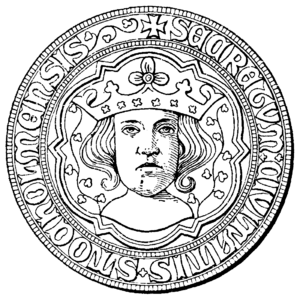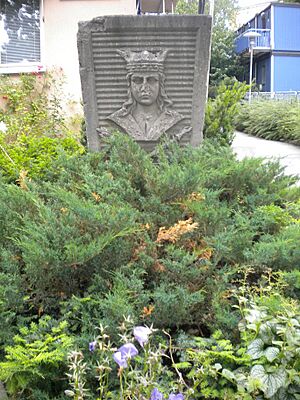Saint Erik facts for kids
Quick facts for kids Saint Erik |
|
|---|---|
 |
|
| King of Sweden | |
| Reign | c. 1156 – 18 May 1160 |
| Predecessor | Sverker I |
| Successor | Magnus II |
| Born | c. 1120-25 |
| Died | 18 May 1160 Uppsala, Sweden |
| Burial | Church of Old Uppsala, later moved to Uppsala Cathedral |
| Spouse | Christina of Denmark |
| Issue Detail |
|
| House | Eric |
| Father | Jedvard |
| Religion | Roman Catholicism |
Saint Erik (also known as Erik Jedvardsson or Eric the Holy) was a Swedish king who ruled from about 1156 to 1160. He is remembered as a saint in the Catholic Church, with his feast day on May 18. Erik started the House of Eric, a royal family that ruled Sweden for many years, from around 1156 to 1250.
Contents
Who Was King Erik?
Erik's family likely came from a region in Sweden called Västergötland. This is because later kings from his family were buried there. Some studies of Erik's bones suggest he lived in Västergötland for 10-15 years before he died. His father's name was Jedvard, which is not a common Swedish name. This might mean his family had some English connections. Erik became king when there was no clear ruler in Sweden. He made his claim to the throne stronger by marrying Christina Björnsdotter, a Danish princess.
Stories About King Erik
There are no writings from Erik's time that tell us much about him. Most of what we know comes from a story written about him much later, in the late 1200s. This story says Erik was chosen as king by everyone. It also says he ruled for ten years, which means he might have been king at the same time as another king, Sverker I. However, after Sverker I died in 1156, Erik was likely accepted as king in most parts of Sweden.
The story also says Erik worked hard to spread Christianity in Sweden. But some older records suggest that Erik and Queen Christina actually caused trouble for monks at a place called Varnhem Abbey. Later, they changed their minds and supported the monks.
King Erik's Journey to Finland
One famous part of Erik's story is his trip to Finland. The legend says he led a "crusade" to Finland to spread Christianity. Finland at that time was not Christian. The story tells that Erik asked the Finns to accept Christianity and make peace. When they refused, he fought them and won. After the battle, Erik was sad that so many people had died. He said he wished they had accepted Christianity so they could have eternal life. He then asked an English bishop named Henry to stay in Finland to teach people about Christianity. Bishop Henry later became a martyr (someone who dies for their faith).
There isn't much proof from other sources about this crusade. However, some old letters from the Pope mention that Finns would promise to become Christian when attacked, but then go back to their old ways when the army left. This suggests Swedes were already visiting Finland. It's likely that if Erik's "crusade" happened, it was more like a quick raid by sea.
What King Erik Achieved
The stories describe Erik as a fair and just ruler. He was said to help people who were treated badly and to remove unfair people from his kingdom. He is also believed to have created a set of laws for Sweden, known as King Eric's Law.
Erik was also known for his strong religious faith. The legend says he prayed often, fasted, and gave money to the poor. He even wore a special shirt made of horsehair, which was a way to show his devotion. Studies of his remains show he ate a lot of fish, which supports the idea that he followed religious fasts.
How King Erik Died
Even though the legend says Erik was king by everyone's choice, this wasn't quite true. Another prince, Magnus Henriksson, also wanted to be king. Magnus was related to earlier Danish and Swedish kings.
The story says Magnus gathered an army with the help of powerful Swedish nobles. They surprised King Erik near Uppsala in May 1160. Erik was attending church on a special holy day. When he heard the enemy was coming, he finished the church service. Then, he and his few men armed themselves and went out to meet Magnus's troops. Erik was pulled from his horse and killed by the rebels.
After King Erik's Death
After Erik's death, Magnus Henriksson became king. But Magnus's rule was short, and he was killed the next year. Then, Charles VII of Sweden, another rival, was killed in 1167. Erik's son, Canute I, returned from exile and eventually became king. Canute defeated his rivals by 1173 and united the kingdom. He used the memory of his father, Saint Erik, to strengthen his own rule. Erik's family, the House of Eric, continued to rule Sweden through Canute's son and grandson.
King Erik's Family
Erik was married to Kristina Björnsdotter from the Danish royal family.
- Children
- Canute I of Sweden, who became King of Sweden from 1167 to 1196.
- Filip Eriksson.
- Catherine, who married Nils Blake.
- Margaret, who married Sverre I of Norway in 1185.
Remembering Saint Erik
King Erik was buried in the Old Uppsala church. Around 1167, his son Canute started to encourage people to honor his father as a martyr (someone who died for their faith). In 1273, Erik's remains were moved to the new Uppsala Cathedral, which was built where he was killed. This move showed how much people respected him.
Today, the Evangelical Lutheran Church in America remembers Erik on May 18. The Roman Catholic Church also remembers him on May 18. In Sweden, people used to have parades on his feast day to ask for good harvests. The Catholic St. Eric's Cathedral, Stockholm, is named after him.
Saint Erik's Reliquary
Uppsala Cathedral still has the special box, called a reliquary, that holds Saint Erik's remains. In the Middle Ages, every new Swedish king would place his hands on this reliquary when taking his oath. The original reliquary was melted down later to help pay for a ransom. The current reliquary was made in the 1570s by King Johan III's Catholic queen, Catherine Jagiellon.
In 2014, researchers opened the reliquary to study its contents. The cathedral even showed Erik's old crown during this time.
Saint Erik's Symbolism
Erik is the patron saint of Sweden and its capital city, Stockholm. His crowned head is shown on Stockholm's coat of arms.
In art, Saint Erik is often shown as a young king being killed during church, sometimes with Bishop Henry of Uppsala. In Uppsala Cathedral, there are old paintings that show Erik and Henry.
Finding the Old Trinity Church
Stories say King Erik was killed while attending Mass at the "Trinity church" in Uppsala. The current Trinity church was built much later. Experts have wondered where the older church was located. Some think it was in the same spot as the current Uppsala Cathedral.
To find out, archaeologists used a special radar (ground-penetrating radar or GPR) to look under the cathedral. Their findings showed there was indeed an older building beneath the cathedral. This older building matches the shape of a 12th-century church. This suggests that the Uppsala Cathedral stands on the very spot of the original Trinity church where King Erik was killed.





